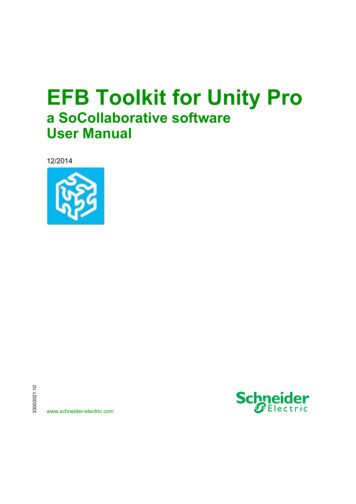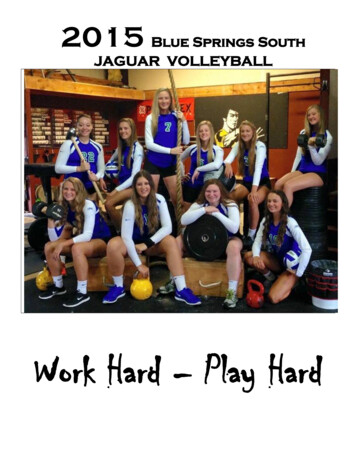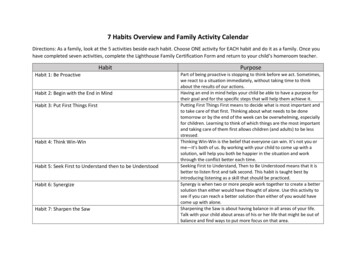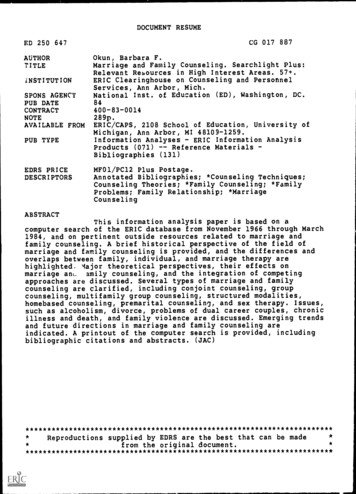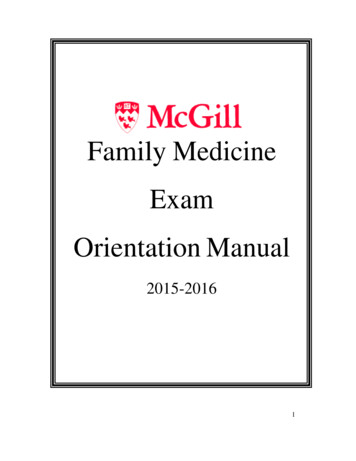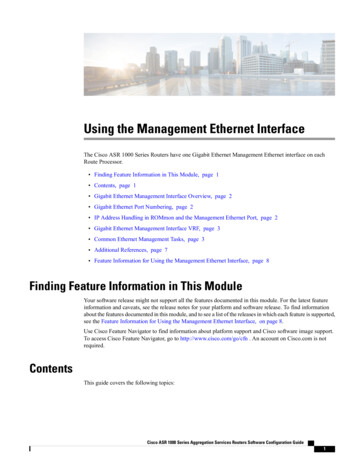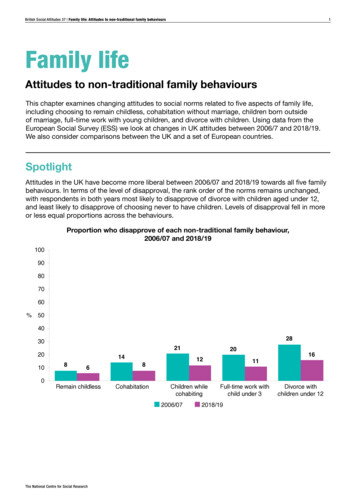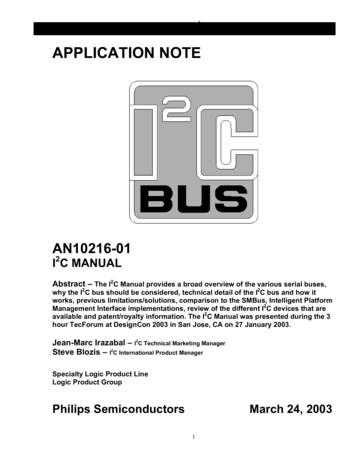
Transcription
AN10216-01 I2C ManualINTEGRATED CIRCUITSAPPLICATION NOTEAN10216-01I2C MANUALAbstract – The I2C Manual provides a broad overview of the various serial buses,why the I2C bus should be considered, technical detail of the I2C bus and how itworks, previous limitations/solutions, comparison to the SMBus, Intelligent PlatformManagement Interface implementations, review of the different I2C devices that areavailable and patent/royalty information. The I2C Manual was presented during the 3hour TecForum at DesignCon 2003 in San Jose, CA on 27 January 2003.Jean-Marc Irazabal – I2C Technical Marketing ManagerSteve Blozis – I2C International Product ManagerSpecialty Logic Product LineLogic Product GroupPhilips SemiconductorsMarch 24, 20031
AN10216-01 I2C ManualTABLE OF CONTENTSTABLE OF CONTENTS .2OVERVIEW .4DESCRIPTION .4SERIAL BUS OVERVIEW.4UART OVERVIEW.6SPI OVERVIEW.6CAN OVERVIEW .7USB OVERVIEW.91394 OVERVIEW .10I2C OVERVIEW .11SERIAL BUS COMPARISON SUMMARY .12I2C THEORY OF OPERATION .13I2C BUS TERMINOLOGY.13START AND STOP CONDITIONS .14HARDWARE CONFIGURATION .14BUS COMMUNICATION.14TERMINOLOGY FOR BUS TRANSFER .15I2C DESIGNER BENEFITS .17I2C MANUFACTURERS BENEFITS .17OVERCOMING PREVIOUS LIMITATIONS .18ADDRESS CONFLICTS .18CAPACITIVE LOADING 400 PF (ISOLATION) .19VOLTAGE LEVEL TRANSLATION .20INCREASE I2C BUS RELIABILITY (SLAVE DEVICES).21INCREASING I2C BUS RELIABILITY (MASTER DEVICES).22CAPACITIVE LOADING 400 PF (BUFFER).22LIVE INSERTION INTO THE I2C BUS .24LONG I2C BUS LENGTHS .25PARALLEL TO I2C BUS CONTROLLER .25DEVELOPMENT TOOLS AND EVALUATION BOARD OVERVIEW.26PURPOSE OF THE DEVELOPMENT TOOL AND I2C EVALUATION BOARD .26WIN-I2CNT SCREEN EXAMPLES.28HOW TO ORDER THE I2C 2002-1A EVALUATION KIT .31COMPARISON OF I2C WITH SMBUS .31I2C/SMBUS COMPLIANCY .31DIFFERENCES SMBUS 1.0 AND SMBUS 2.0 .32INTELLIGENT PLATFORM MANAGEMENT INTERFACE (IPMI) .32INTEL SERVER MANAGEMENT.33PICMG .33VMEBUS .34I2C DEVICE OVERVIEW .35TV RECEPTION.36RADIO RECEPTION .362
AN10216-01 I2C ManualAUDIO PROCESSING .37DUAL TONE MULTI-FREQUENCY (DTMF).37LCD DISPLAY DRIVER .37LIGHT SENSOR .38REAL TIME CLOCK/CALENDAR .38GENERAL PURPOSE I/O EXPANDERS .38LED DIMMERS AND BLINKERS .40DIP SWITCH .42MULTIPLEXERS AND SWITCHES.43VOLTAGE LEVEL TRANSLATORS .45BUS REPEATERS AND HUBS .45HOT SWAP BUS BUFFERS .45BUS EXTENDERS .46ELECTRO-OPTICAL ISOLATION .47RISE TIME ACCELERATORS .47PARALLEL BUS TO I2C BUS CONTROLLER .48DIGITAL POTENTIOMETERS .48ANALOG TO DIGITAL CONVERTERS .48SERIAL RAM/EEPROM .49HARDWARE MONITORS/TEMP & VOLTAGE SENSORS .49MICROCONTROLLERS .49I2C PATENT AND LEGAL INFORMATION .50ADDITIONAL INFORMATION .50APPLICATION NOTES.503
AN10216-01 I2C ManualOVERVIEWDescriptionPhilips Semiconductors developed the I2C bus over 20 years ago and has an extensive collection of specific use andgeneral purpose devices. This application note was developed from the 3 hour long I2C Overview TecForum presentationat DesignCon 2003 in San Jose, CA on 27 January 2003 and provides a broad overview of how the I2C bus compares toother serial buses, how the I2C bus works, ways to overcome previous limitations, new uses of I2C such as in theIntelligent Platform Management Interface, overview of the various different categories of I2C devices and patent/royaltyinformation. Full size Slides are posted as a PDF file on the Philips Logic I2C collateral web site as DesignCon 2003TecForum I2C Bus Overview PDF file. Place holder and title slides have been removed from this application note andsome slides with all text have been incorporated into the application note speaker notes.three shared signal lines, for bit timing, data, and R/W.The selection of communicating partners is made withone separate wire for each chip. As the number of chipsgrows, so do the selection wires. The next stage is touse multiplexing of the selection wires and call them anaddress bus.Serial Bus OverviewCommunicationersumConsIf there are 8 address wires we can select any one of256 devices by using a ‘one of 256’ decoder IC. In aparallel bus system there could be 8 or 16 (or more)data wires. Taken to the next step, we can share thefunction of the wires between addresses and data but itstarts to take quite a bit of hardware and worst is, westill have lots of wires. We can take a differentapproach and try to eliminate all except the data wiringitself. Then we need to multiplex the data, the selection(address), and the direction info - read/write. We needto develop relatively complex rules for that, but we saveon those wires. This presentation covers buses that useonly one or two data lines so that they are still attractivefor sending data over reasonable distances - at least afew meters, but perhaps even USDesignCon 2003 TecForum I2C Bus Overview5Slide 5General concept for Serial communicationsSCLDATAShift RegisterParallel to SerialSDAselect 3select 2select 1READorWRITE?“MASTER”Typical Signaling CharacteristicsenableR/WShift Reg#// to Ser.SLAVE 1enableR/
1.5 Mbits/sec speeds of USB version 1.1) and Hi-Speed USB meaning the faster 480 Mbits/sec option included in spec versi on 2.0. Parts cnformng t r capable of the 480 Mbits/sec are certified as Hi-Speed USB and will then feature the logo with the red stripe “Hi-Speed” fitted above the standard USB logo. The reason to avoid use of the new spec version 2.0 as a generic name is that this .

